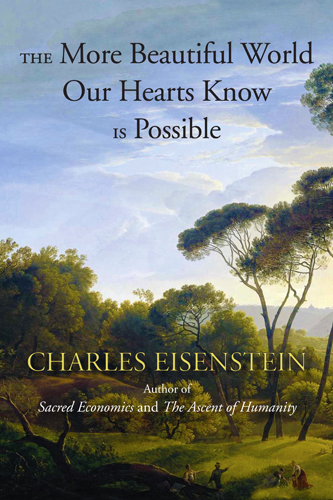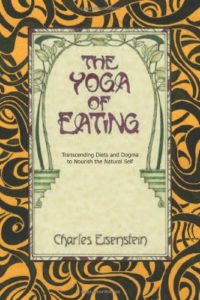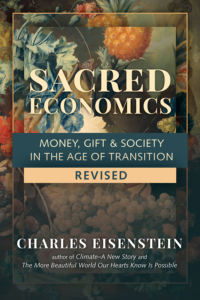Climate — A New Story
Chapters
Chapter 8: Regeneration
Feeding a Hungry Planet
I hope the above descriptions of regenerative farms put to rest the notion that industrial agriculture is needed to feed a hungry planet. Not only is it unsustainable long term, but it doesn’t even outperform ecological agriculture in the short term. Again, quantitative proof of this claim is hard to come by. Most regenerative farms have no need to maximize food productivity per acre.
Some readers might protest that scientific studies typically show organic crop yields to be lower than conventional yields. Here we must look at what these studies take for granted. The high yields of small mixed farms are hard to measure because they typically produce multiple crops that may not find their way to commodity markets, but instead are consumed locally, via farm share programs or farmers markets, sometimes outside the money economy. Moreover, traditional forms of agriculture often employ multicropping and intercropping. So while an organic corn field will underperform a GMO corn field, what about the total yield of a corn field that also grows beans and squash, and is patrolled by free ranging chickens who eat the bugs? What about when insect-damaged fruit or vegetable seconds feed pigs or other livestock?
Optimal results come from long, even multigenerational, experience applied in intimate relationship to each farm. Comparisons of organic and conventional agriculture often use organic farms recently converted from conventional practices; rarely do they consider the most highly evolved farms where soil, knowledge, and practices have been rebuilt over decades.
I asked my brother, an organic vegetable farmer on 120 acres of land, what it would take for him to maximize food production in an ecologically sustainable way. (At present, he farms only about a tenth of that land.) In his typical laconic manner, he replied, “About two hundred people.” If he converted the woodlands (severely degraded by 150 years of repeated logging) to agroforestry; if he put in water retention ponds and raised fish there; if he converted cultivated land to perennials and no-till intercropping; if he applied mob grazing to the pastureland; if he had a composting biogas operation to generate heat and electricity … he could grow twenty times more food than he does today. But he doesn’t have the two hundred people necessary to implement all these things; he has, depending on the season, between one and ten. So, his operation is based on generating a high output per unit of labor, not per unit of land.
This might explain why, around the world, small farms far outperform large farms in terms of yield. First observed by Nobel economist Amartya Sen in 1962, it has been confirmed by numerous studies in many countries. The best-known recent study looked at small farms in Turkey, which still has a strong base of traditional peasant agriculture.[13] Small farms there outproduced large farms by a factor of 20, despite (or because of?) their slower adoption of modern methods. Yet, the narrative of modern agriculture feeding the world is so strong that the OECD stated that “stopping land fragmentation” in Turkey “and consolidating the highly fragmented land is indispensable for raising agricultural productivity.”[14]
Of course, small farms can be ecologically destructive just as large farms can, but in general, the worst abuses happen at industrial scale. Small farmers are much better able to put intensive care into their land, read its signs, and respond flexibly.
Figuratively and literally, we need to go back to the land. Unfortunately, U.S. policy has encouraged the opposite, aggressively pushing the interests of large agribusinesses around the globe. Thankfully, many countries, localities, and farmers have resisted this push. Most notably, France, Germany, Venezuela, and Russia have banned cultivation of genetically modified crops; Russia has banned their importation as well, as part of a nationwide transition to organic agriculture. This is about more than GMOs; it is about a whole model of industrial agriculture that goes along with it.
Is it practical to transition to a radically different model of agriculture in time to avert ecological catastrophe? My colleague Marie Goodwin attended a meeting of the Delaware Valley Regional Planning Commission about food security and arable land in the Philadelphia metropolitan region. The presiding official’s presentation showed that the amount of farmland in the region was far less than that required to feed so many people should there be a breakdown in the global food system. Marie pointed out that if you included lawns, there would be enough land to feed everyone. The official was dismissive. “That’s impossible,” she said. “We could never get people to grow enough food at home to make any difference.”
Marie points out that in the U.S. during the Second World War, victory gardens were responsible for 40 percent of all vegetables grown during that period: 9–10 million tons. It was an even greater percentage in Britain. This just goes to show how our notions of what is possible or realistic depend on cultural perceptions. Cultural perceptions can change, must change, and are changing. If by realistic we mean keeping everything the same, then we are going to have to stop being so “realistic.”
Given the ruinous course we are on today, a more accurate word for “realistic” is actually “fatalistic.” Again I’ll quote Eileen Crist:
In fatalistic thinking, the trajectory of industrial-consumer civilization appears set on tracks that humanity cannot desert without derailing; it is implied that while the specifics of the future may elude us, in broad outline it is (for better or for worse) a fixed direction of more of the same. Fatalism projects the course of human history (and concomitantly of natural history) as the inevitable unfolding of the momentum of present trends. By virtue of the inertia that massive forces display, from a fatalistic viewpoint, present patterns of global economic expansion, consumption increase, population growth, conversion and exploitation of the land, killing of wildlife, extinction of species, chemical contamination, depletion of oceans, and so on, will more or less keep unfolding.[15]
For there to be meaningful healing on this planet, “impossibilities” like more people growing food cannot remain impossible. We are indeed talking about a wholesale civilizational transformation.
Yes, it would require spending more time per capita on food production to feed ourselves and heal the land at the same time. It might require widespread home gardens, and government policies to encourage them. It might require 10 percent or 20 percent of the population to be involved in agriculture, not 1 percent. In a time of increasing global unemployment, this should not be a problem.
A model for a way forward might be found in Russia. In 2003, Russia promulgated the Private Garden Plot Act, which entitled every citizen to a tax-free private plot of several acres of land for gardening or recreation and accelerated the dacha and ecovillage movement there. As of 2016, small plots provided nearly half of Russia’s food.[16] In many developed countries, though, agricultural regulations, zoning laws, building codes, and so on make it difficult if not illegal to farm ecologically, especially for the small farmer. In America, for example, concerns about food safety have led to prohibitions on mixing livestock and crops. No more ducks eating slugs or chickens controlling insects. No more dogs protecting fields from woodchucks and deer. Complicated regulations that were created to rein in large producers’ irresponsible behavior can be prohibitively time-consuming and expensive for the small farmer, who does not have a compliance department to manage the paperwork. The regulations were created for, and to a large extent by, large producers. Newly proposed regulations require documentation of each time livestock is moved. This is no problem for a confinement operation with thousands of hogs or chickens that are occasionally moved en masse. It is impossible for a small ecological farm to comply, when it may have a few dozen head of livestock and a small flock of poultry that is constantly moving.
Outside agriculture, other regulations are misaligned with ecological needs. Tiny homes do not meet building code size requirements. Homes using composting toilets and graywater aquaponics systems nonetheless have to install expensive and unnecessary septic systems.
To align our society with ecological healing is not impractical. It just needs a shift in our perceptions, priorities, and laws. Nature’s tendency is toward wholeness, if we only align ourselves with it instead of fighting to keep things the same.
On the level of national and global policy, a transition to regenerative agriculture would require significant political will and leadership. Many farmers today are stretched to the limit by their debt obligations, making it impossible to afford a few years of lower income while transitioning their farm. Some kind of public subsidy is needed to support the transition. I think the best way to accomplish this would be to reassign existing subsidies (agriculture is already highly subsidized in many countries). In the U.S., some 85 percent of farm subsidies go to the largest 15 percent of farm operations.[17] Annual farm subsidies are at least $20 billion in the U.S. and even more in the EU. Using just half that, one hundred thousand American small farms a year could each receive a $100,000 three-year transition subsidy. That is a slow enough pace to avoid disruptions in the food supply, and fast enough to make a significant ecological difference. I will be happy to donate the dinner napkin on which I made these calculations to Congress.
Then there is the labor problem—except that there isn’t one. Here again we can simply redirect existing resources. Youth unemployment is at least 10 percent in the U.S. and nearly 20 percent in Europe. Moreover, governments around the world, especially the U.S., spend vast sums to induce young people to join the military, or even require them to do so. Among the American working class and underclass, many choose military service because of an idealistic desire to serve, coupled with a lack of economic opportunity in any other field except illegal drugs. Unfortunately, this idealism depends on obsolescing narratives such as “America, bringing liberty and democracy to the world” that are actually cover stories for imperialism. As the age of empire dwindles, these narratives are losing their power, yielding to a creeping cynicism within the military, and especially among veterans. If I may make an immodest proposal, what if we met these twin needs of service to the world and economic security by creating an eco-corps, dedicated to ecological healing and to the service of all life on earth?
Ecological healing works in both directions: working with plants, animals, soil, and water has powerful therapeutic benefits.[18] Modalities like horticulture therapy and garden therapy show impressive results for at-risk youth, prisoners, veterans, and people with chronic diseases, not surprising when we understand health as wholeness, and disconnection as disease. Psychiatric conditions in particular improve with interaction with nature, lending credence to the view that most of them are symptoms of “nature deficit disorder.” Conditions like ADHD, depression, and anxiety often improve or disappear entirely when the individual interacts regularly and meaningfully with the natural world. The healing of individuals, society, and the world go hand in hand.
End Notes
[13] Ünal (2008).
[14] Monbiot (2008).
[15] Crist (2007), 54.
[16] Russian Federation (2018).
[17] Smith (2016).
[18] In case you need peer-reviewed confirmation of this assertion, which seems obvious at face value, you can start with: Soga et al. (2017).






